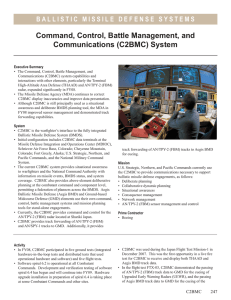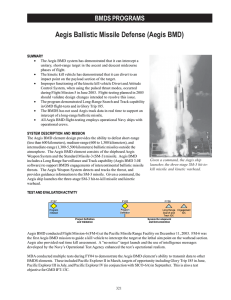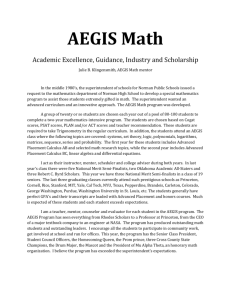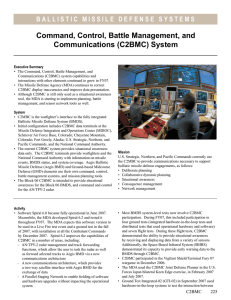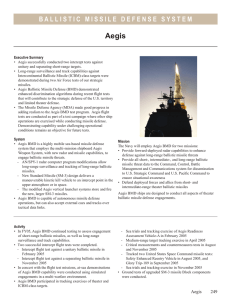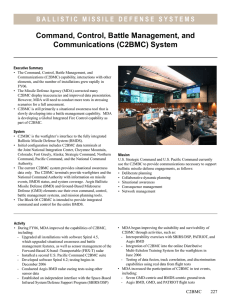Aegis Ballistic Missile Defense (BMD)
advertisement
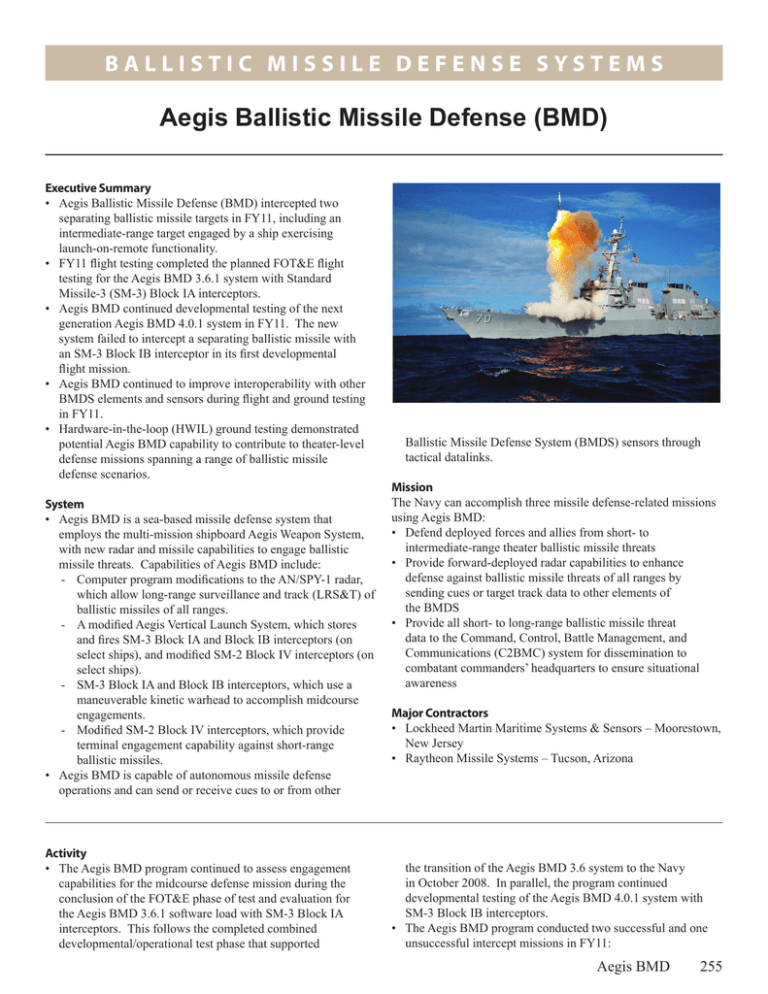
BALL I ST I C M I SS I LE DE F ENSE SYSTEMS Aegis Ballistic Missile Defense (BMD) Executive Summary • Aegis Ballistic Missile Defense (BMD) intercepted two separating ballistic missile targets in FY11, including an intermediate-range target engaged by a ship exercising launch‑on-remote functionality. • FY11 flight testing completed the planned FOT&E flight testing for the Aegis BMD 3.6.1 system with Standard Missile-3 (SM-3) Block IA interceptors. • Aegis BMD continued developmental testing of the next generation Aegis BMD 4.0.1 system in FY11. The new system failed to intercept a separating ballistic missile with an SM-3 Block IB interceptor in its first developmental flight mission. • Aegis BMD continued to improve interoperability with other BMDS elements and sensors during flight and ground testing in FY11. • Hardware-in-the-loop (HWIL) ground testing demonstrated potential Aegis BMD capability to contribute to theater-level defense missions spanning a range of ballistic missile defense scenarios. System • Aegis BMD is a sea-based missile defense system that employs the multi-mission shipboard Aegis Weapon System, with new radar and missile capabilities to engage ballistic missile threats. Capabilities of Aegis BMD include: - Computer program modifications to the AN/SPY-1 radar, which allow long-range surveillance and track (LRS&T) of ballistic missiles of all ranges. - A modified Aegis Vertical Launch System, which stores and fires SM-3 Block IA and Block IB interceptors (on select ships), and modified SM-2 Block IV interceptors (on select ships). - SM-3 Block IA and Block IB interceptors, which use a maneuverable kinetic warhead to accomplish midcourse engagements. - Modified SM-2 Block IV interceptors, which provide terminal engagement capability against short-range ballistic missiles. • Aegis BMD is capable of autonomous missile defense operations and can send or receive cues to or from other Activity • The Aegis BMD program continued to assess engagement capabilities for the midcourse defense mission during the conclusion of the FOT&E phase of test and evaluation for the Aegis BMD 3.6.1 software load with SM-3 Block IA interceptors. This follows the completed combined developmental/operational test phase that supported Ballistic Missile Defense System (BMDS) sensors through tactical datalinks. Mission The Navy can accomplish three missile defense-related missions using Aegis BMD: • Defend deployed forces and allies from short- to intermediate‑range theater ballistic missile threats • Provide forward-deployed radar capabilities to enhance defense against ballistic missile threats of all ranges by sending cues or target track data to other elements of the BMDS • Provide all short- to long-range ballistic missile threat data to the Command, Control, Battle Management, and Communications (C2BMC) system for dissemination to combatant commanders’ headquarters to ensure situational awareness Major Contractors • Lockheed Martin Maritime Systems & Sensors – Moorestown, New Jersey • Raytheon Missile Systems – Tucson, Arizona the transition of the Aegis BMD 3.6 system to the Navy in October 2008. In parallel, the program continued developmental testing of the Aegis BMD 4.0.1 system with SM-3 Block IB interceptors. • The Aegis BMD program conducted two successful and one unsuccessful intercept missions in FY11: Aegis BMD 255 BALL I ST I C M I SS I LE DE F ENSE SYSTEMS In October 2010 during Japan Flight Test Standard Missile-4 (JFTM-4), a Japanese Aegis BMD destroyer intercepted a short-range separating target with an SM-3 Block IA interceptor. JFTM-4 also included two tracking events with separating ballistic missile targets, one of which included a cued simulated engagement by an Aegis BMD 3.6.1 destroyer. An Aegis BMD cruiser with an engineering load of 4.0.1 software also participated during the JFTM-4 events and conducted simulated engagements. During Flight Test Standard Missile-15 (FTM-15) in April 2011, an Aegis BMD 3.6.1 destroyer, set up with remote engagements authorized, intercepted an intermediate-range separating target with an SM-3 Block IA interceptor using up-range track data from an AN/TPY-2 radar in forward-based mode (FBM). The FTM15 engagement was the first intercept of an intermediaterange ballistic missile with an SM-3 Block IA interceptor, and the first intercept mission with a ship set up with remote engagements authorized. FTM-15 supports the assessment of Phase 1 of the Phased Adaptive Approach (PAA) for defense of Europe. During FTM-16 Event 2 in September 2011, an Aegis BMD cruiser with 4.0.1 software failed to intercept a simple separating ballistic missile target with an SM-3 Block IB interceptor. FTM-16 Event 2 was the first intercept attempt for the new Aegis BMD 4.0.1 system with SM-3 Block IB interceptors. • In FY11, Aegis BMD participated in several BMDS system flight and ground tests to assess Aegis BMD functionality and interoperability with the BMDS: - Aegis BMD participated in the Fast Eagle HWIL exercise in October 2010, during which ballistic missile defense capabilities were explored using laboratory assets for Aegis BMD, AN/TPY-2 (FBM), C2BMC, Space-Based Infrared System (SBIRS), and Patriot, with U.S. military operators manning the systems. - Laboratory and digital representations of Aegis BMD participated in Assured Response-04X in October 2010, a BMD exercise designed to develop and refine Concepts of Operations and tactics, techniques, and procedures, and to demonstrate BMDS capabilities. - Aegis BMD participated in Flight Test Ground-based Interceptor (FTG)-06a in December 2010, during which a cruiser with an engineering load of 4.0.1 software assessed the capability to conduct LRS&T on an intermediate-range multi-stage ballistic missile target and transmit track data to the BMDS using Link 16. The test also assessed launch‑on-remote support capability by conducting a simulated SM-3 launch from a surrogate destroyer with 3.6.1.2 software based on live AN/TPY-2 (FBM) track data. - FTM-15 System Pre-Mission Test-1 (December 2010) and -2 (February 2011) utilized laboratory representations of Aegis BMD (3.6.1), AN/TPY-2, and C2BMC to 256 Aegis BMD - - - - - - - - characterize performance for the test scenario in FTM-15 as risk reduction studies prior to the flight mission. Ground Test Distributed (GTD)-04b in February and March 2011 explored engagement capability against short-, medium-, intermediate-, and long-range ballistic missile threats using three Aegis BMD laboratory facilities and representations of other BMDS assets. Laboratory and digital representations of Aegis BMD participated in Assured Response-04D in March 2011, which was a distributed exercise incorporating regionally focused active defense scenarios for architectures similar to those to be fielded as part of Phase 1 of the PAA for defense of Europe. During FTM-16 Event 1 in March 2011, an Aegis BMD 4.0.1 cruiser conducted a simulated engagement against a complex separating short-range ballistic missile with an SM-3 Block IB simulated dynamic interceptor. Separate events following Event 1 tested BMD 4.0.1 anti-air warfare capability. Flight Test Other (FTX)-16 Event 1 in March 2011 assessed the capability of Aegis BMD 3.6.1 to conduct a simulated engagement of a short-range ballistic missile using track data from the Space Tracking and Surveillance System. Ground Test Integrated (GTI)-04d Part 1 in July 2011 and Part 2 in October 2011 tested the engagement capabilities of existing missile defense systems against short- and medium-range ballistic missiles, and tested system-level sensor resource management and tasking in an HWIL environment in support of a PAA Phase 1 assessment. Participants included SBIRS, Aegis BMD (laboratory sites with 3.6.1 software), AN/TPY-2 (FBM), and C2BMC. Technical Assessment-04 in July 2011 explored PAA Phase 1 capability of the BMDS in the context of defending European allies and deployed forces from medium-range ballistic missile threats by simultaneously executing multiple theater engagements with Aegis BMD (3.6.1), AN/TPY-2 (FBM), and C2BMC in a digital modeling and simulation environment. Ground Test Distributed-04d Part 1, conducted August to September 2011, consisted of a distributed ground test focusing on the communication architecture that will be deployed in PAA Phase 1. Participants included Aegis BMD (3.6.1), AN/TPY-2 (FBM), and C2BMC in a distributed environment using operational communication systems and operationally representative crews. FTM-15 completed the planned FOT&E flight testing for the Aegis BMD 3.6.1 system with SM-3 Block IA interceptors. However, additional testing of the 3.6.1 system will occur during ground testing and in the upcoming Flight Test Operational (FTO)-01 mission in 4QFY12. FTO-01 will be an operational test of the BMDS. BALL I ST I C M I SS I LE DE F ENSE SYSTEMS Assessment • In FY11, Aegis BMD demonstrated, for the first time, the capability to engage an intermediate-range separating ballistic missile in the midcourse phase with an SM-3 Block IA interceptor. In that engagement, the firing ship used track data forwarded by C2BMC from an AN/TPY-2 (FBM) radar to develop a firing solution. The engagement, which exercised Aegis BMD 3.6.1 launch-on-remote functionality, demonstrated an important type of engagement capability needed to support Phase 1 of the PAA for defense of Europe. Cued engagements against longer-range targets would be expected in the European theater. • Anomalous behavior was observed during the flyout of the SM-3 Block IA interceptor in FTM-15, but the anomaly did not preclude an intercept. If the anomaly occurred under different engagement conditions, it could have had an impact on the success of the engagement. However, it should be noted that the anomaly was not observed in any of the 21 previous SM-3 flyouts. The cause of the anomaly is under investigation by the program. • Aegis BMD continues to improve its interoperability with other BMDS elements and sensors, as demonstrated in recent ground testing. Improvements in interoperability are still needed, however, to ensure that Aegis BMD can send and receive cues and track data of sufficient quality to support PAA Phase 1, which will be deployed at the end of CY11. • FTM-16 Event 2 failed to demonstrate the capability to intercept a ballistic missile with the new SM-3 Block IB interceptor fired from an Aegis BMD 4.0.1 ship. Although the interceptor failed to intercept the target, many of the new capabilities of the Aegis BMD 4.0.1 system were exercised during the mission, and functioned as designed. FTM-16 Event 2 was the first developmental firing mission with the Aegis BMD 4.0.1 system. A Failure Review Board is determining the root cause. Recommendations • Status of Previous Recommendations. The program addressed the single recommendation from FY10, when it conducted a launch-on-remote engagement against an intermediate-range target in FTM-15. • FY11 Recommendation. 1. The MDA should repeat flight tests to verify root causes and Failure Review Board results for the anomalous behaviors of the SM-3 Block 1A and Block 1B interceptors to confirm permanent fixes to the problems the boards discovered. Aegis BMD 257 BALL I ST I C M I SS I LE DE F ENSE SYSTEMS 258
